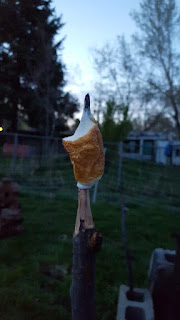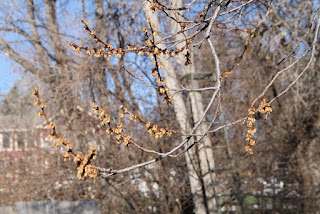With overnight lows consistently staying above freezing, it seems like the sap flow is pretty much wrapping up around here. That means it's time to look back through our notebook and write up the results!
How did it go? Overall, not particularly well. But we did get about three cups of syrup, and other reports we've heard from different parts of the country have said they also didn't have a very good year. The 2016 spring weather just didn't cooperate. But, we definitely got some informative results, and we can put at least one data point out there on the internets for future reference.
In general, the box elders were the only trees in our yard that produced a useful amount of sap. We got about a gallon (total) from the smaller elm, about a quart from the Lombardy poplar, and about a pint from one of the Bradford pears. The Tree of Heaven, the other elm, and the other pear didn't produce anything. The box elders were also running earlier than the rest of them--they were dripping when we tapped them on February 7, and had pretty much wrapped up by the end of February, which is when the elm got started. The elm and poplar are actually still flowing now, but now that we know what the sap tastes like (see below), we probably won't bother collecting the sap any more.
 |
| The box elders started out strong, but petered out by the end of
February. The dates with the symbols are when we harvested (except 2/7, which was when we set the taps). We should
have been harvesting more frequently; this site
recommends collecting sap every two days to keep the quality of the resulting
syrup from degrading and/or to keep microbes from moving in and eating the precious
sugar. |
Early on, we harvested the box elders about once a week because the three-gallon buckets were full; the long gap between the end of February and the end of March was due to us waiting for a usable amount of sap to accumulate. As noted in the caption above, we should have collected more frequently and stored the sap in the fridge, which would have both mitigated off flavors and given a better estimate of when the peak run was. But, we've got some sap now, so we might as well analyze it!
 |
| Test #1: the 'sugar' content. The box elder was showing about 2% sugar, which was slightly down from the earlier runs of 2.5% (it was also cloudy, when earlier runs were clear). The Bradford pear was at about 0.7%, the Siberian elm was also at about 2%, and the Lombardy poplar at about 2.5%. However, most of that increase in density relative to water was probably due to dissolved stuff other than sugar, because... |
 |
| Test #2: the taste (and color)! To be frank, they all tasted gross. The earlier runs of box elder actually had a detectable sweetness to them, but not this time. They did all taste slightly like the wood smells when you cut it. |
Or, in other words, here's our best description of the flavors:
- For the box elder, it's sort of astringent and mildly acidic,
- For the pear
it's...not much of anything, but it still somehow off-putting,
- For the elm it's sort of like wet leaves in the
fall, but somewhat more phenolic (if that helps...),
- For the poplar it's more strongly astringent and more earthy than the box elder. Also,
really bitter.
It's possible that the flavors changed while sitting out for almost a month, but we did try fresh elm sap that only sat for a day and it wasn't any better.
The colors didn't change much on sitting, and they smelled about the same, too. Katie tried the elm, but none of the others, and generally concurred
with the above assessment. Actually, her response was something along
the lines of, "if you already knew what it tasted like, why would you
ever want me to try it?!" (For science, of course!)
Needless to say, we didn't bother making syrup out of any of the non-box elder saps, and we won't bother tapping any of our trees other than the box elder next year. But now we know, and now you know, too!
How did your sugaring season go this year?

































